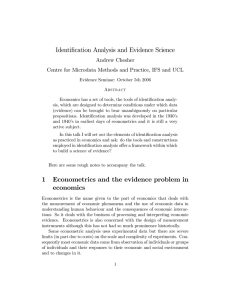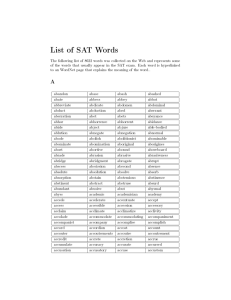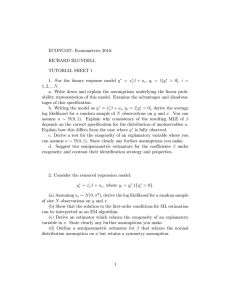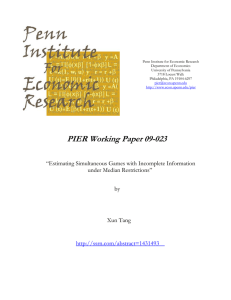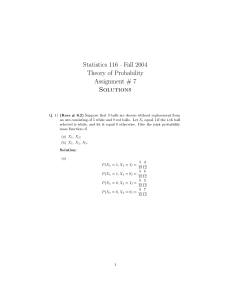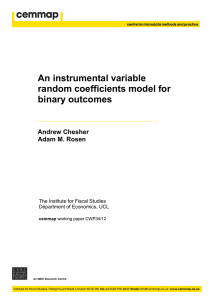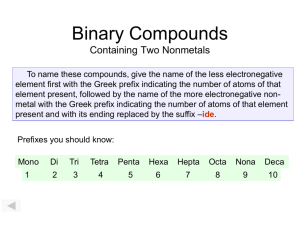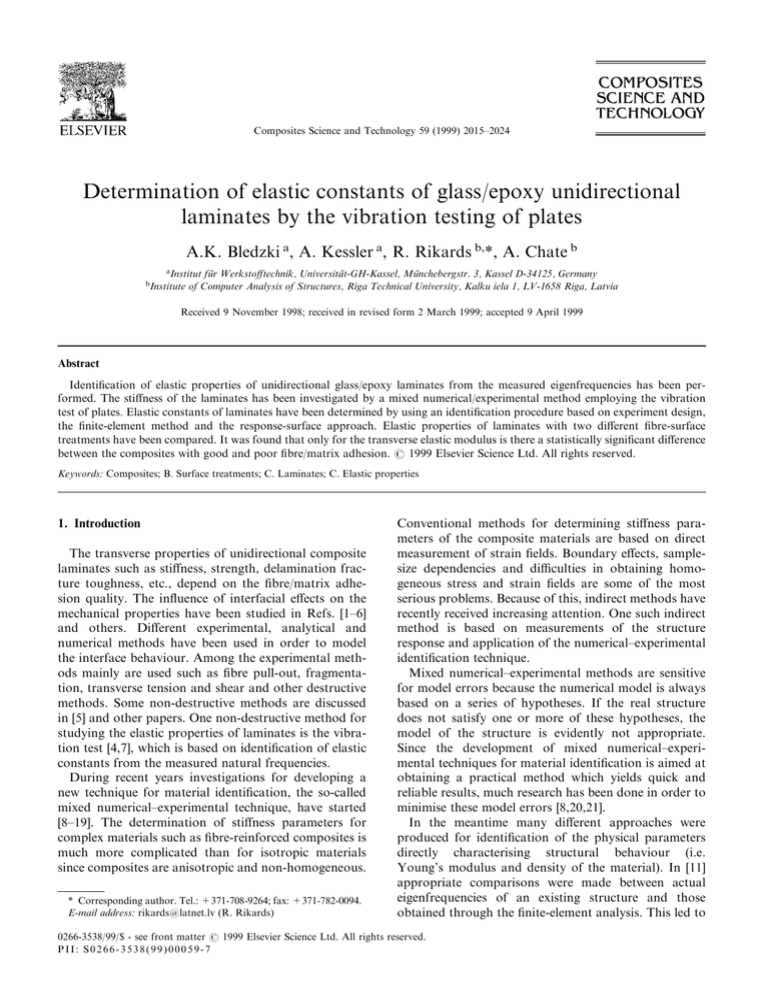
Composites Science and Technology 59 (1999) 2015±2024
Determination of elastic constants of glass/epoxy unidirectional
laminates by the vibration testing of plates
A.K. Bledzki a, A. Kessler a, R. Rikards b,*, A. Chate b
a
Institut fuÈr Werkstotechnik, UniversitaÈt-GH-Kassel, MuÈnchebergstr. 3, Kassel D-34125, Germany
Institute of Computer Analysis of Structures, Riga Technical University, Kalku iela 1, LV-1658 Riga, Latvia
b
Received 9 November 1998; received in revised form 2 March 1999; accepted 9 April 1999
Abstract
Identi®cation of elastic properties of unidirectional glass/epoxy laminates from the measured eigenfrequencies has been performed. The stiness of the laminates has been investigated by a mixed numerical/experimental method employing the vibration
test of plates. Elastic constants of laminates have been determined by using an identi®cation procedure based on experiment design,
the ®nite-element method and the response-surface approach. Elastic properties of laminates with two dierent ®bre-surface
treatments have been compared. It was found that only for the transverse elastic modulus is there a statistically signi®cant dierence
between the composites with good and poor ®bre/matrix adhesion. # 1999 Elsevier Science Ltd. All rights reserved.
Keywords: Composites; B. Surface treatments; C. Laminates; C. Elastic properties
1. Introduction
The transverse properties of unidirectional composite
laminates such as stiness, strength, delamination fracture toughness, etc., depend on the ®bre/matrix adhesion quality. The in¯uence of interfacial eects on the
mechanical properties have been studied in Refs. [1±6]
and others. Dierent experimental, analytical and
numerical methods have been used in order to model
the interface behaviour. Among the experimental methods mainly are used such as ®bre pull-out, fragmentation, transverse tension and shear and other destructive
methods. Some non-destructive methods are discussed
in [5] and other papers. One non-destructive method for
studying the elastic properties of laminates is the vibration test [4,7], which is based on identi®cation of elastic
constants from the measured natural frequencies.
During recent years investigations for developing a
new technique for material identi®cation, the so-called
mixed numerical±experimental technique, have started
[8±19]. The determination of stiness parameters for
complex materials such as ®bre-reinforced composites is
much more complicated than for isotropic materials
since composites are anisotropic and non-homogeneous.
* Corresponding author. Tel.: +371-708-9264; fax: +371-782-0094.
E-mail address: rikards@latnet.lv (R. Rikards)
Conventional methods for determining stiness parameters of the composite materials are based on direct
measurement of strain ®elds. Boundary eects, samplesize dependencies and diculties in obtaining homogeneous stress and strain ®elds are some of the most
serious problems. Because of this, indirect methods have
recently received increasing attention. One such indirect
method is based on measurements of the structure
response and application of the numerical±experimental
identi®cation technique.
Mixed numerical±experimental methods are sensitive
for model errors because the numerical model is always
based on a series of hypotheses. If the real structure
does not satisfy one or more of these hypotheses, the
model of the structure is evidently not appropriate.
Since the development of mixed numerical±experimental techniques for material identi®cation is aimed at
obtaining a practical method which yields quick and
reliable results, much research has been done in order to
minimise these model errors [8,20,21].
In the meantime many dierent approaches were
produced for identi®cation of the physical parameters
directly characterising structural behaviour (i.e.
Young's modulus and density of the material). In [11]
appropriate comparisons were made between actual
eigenfrequencies of an existing structure and those
obtained through the ®nite-element analysis. This led to
0266-3538/99/$ - see front matter # 1999 Elsevier Science Ltd. All rights reserved.
PII: S0266-3538(99)00059-7
2016
A.K. Bledzki et al. / Composites Science and Technology 59 (1999) 2015±2024
the identi®cation of parameters which can be used for
the model calibration as well as for the detection of
damaged zones in the structure.
Numerical±experimental identi®cation methods are
mainly used in structural applications [8±19]. For
example, in [8] elastic properties of laminated composites have been identi®ed by using experimental eigenfrequencies. The stiness parameters were identi®ed
from the measured natural frequencies of the laminated
composite plate by direct minimisation of the identi®cation functional. A similar approach to identifying the
stiness properties of the laminated composites was
used in [18,19,22]. In [20] an improved plate model was
used for identi®cation of elastic constants of the laminate. In [23] it was shown that the mixed numerical±
experimental method can also be used for identi®cation
of damping properties of polymeric composites.
In the present study the numerical±experimental
method for identi®cation of mechanical properties of
laminated polymeric composites from the experimental
results of the structure response has been further developed. The dierence between the conventional [8,20]
and the present approach is that, instead of direct
minimisation of the identi®cation function, experimental
design is used, by which response surfaces of the function to be minimised are obtained. The response surface
approximations are obtained by using information on
the behaviour of a structure in the reference points of
the experiment design. Note that ®nite-element modelling of the structure is performed only in the reference
points. The function to be minimised describes the
dierence between the measured and numerically calculated parameters of the response of structure. By minimising the function the identi®cation parameters were
obtained. The method was employed to identify the
elastic properties of the laminates from the measured
eigenfrequencies of the plates. The main advantage of the
present method is a signi®cant reduction of the computational eort. Previously this method was used for the
solution of the optimum design problems [24±27].
In the present study the numerical±experimental
method has been applied for identi®cation of elastic
properties of glass/epoxy laminates with two dierent
®bre-surface treatments. Experiments were performed
on laminated plates and about 16 natural frequencies
were measured. Elastic properties obtained from vibration tests have been compared with those from the
transverse tensile test.
types of surface treatments. The ®rst type was treated by
epoxy dispersion with aminosilane to promote good
®bre/matrix adhesion. More details about this ®bre
treatment can be found in [28,29]. For this composite
the notation EP is used. The second type was sized with
polyethylene to prevent ®bre/matrix adhesion. For this
composite the notation PE is used. A Ciba Geigy Ltd.
Araldite epoxy system (LY556/917/DY070) with an
ultimate tensile strain of 3.3% was used as the matrix
material.
Unidirectionally reinforced test samples were produced on a winding machine. The content of micropores
was below 0.75% by volume. The glass ®bre-reinforced
plates (see Fig. 1) were prepared with given geometric
parameters. The total number of plies was eight in order
to get a plate thickness of approximately 2 mm. The EP
and PE laminates were produced by following the standard cure cycle recommended by Ciba Geigy Ltd. To
improve the quality of the plates and to reduce the void
content, the plates were placed in a vacuum before curing. Specimens were cut out with a diamond wheel and
kept under standard conditions (23 C and 50% of relative humidity) until testing. All tests were performed in
the same conditions. The ®bre content of the specimens
was about 501.5 vol%. The density was measured for
each specimen. The specimen geometric parameters and
density for the unidirectionally (UD) reinforced PE
composite plates are presented in Table 1. Similar data
for the EP composite plates were given in [7].
2.2. Vibration tests
The eigenfrequencies of the test plates were measured
by a real-time television (TV) holography. The samples
having mean dimensions of 140 mm140 mm2 mm
were hung upon two threads in order to simulate free±
free boundary conditions. The sample was located in
front of the holographic testing device. A piezoelectric
resonator (sensor) was glued on one corner to excite the
sample plate at increasing frequencies. The sensor is of
2. Experimental
2.1. Material
Unidirectionally reinforced laminates were produced
from E-glass ®bres (12 mm, 63 tex) with two dierent
Fig. 1. Geometry of the unidirectionally reinforced plate.
A.K. Bledzki et al. / Composites Science and Technology 59 (1999) 2015±2024
circular shape with a diameter 25 mm located at the
coordinates x a ÿ 12:5 mm and y b ÿ 12:5 mm (see
Fig. 1). The mass of the sensor is ms 3:5 g.
The plate is illuminated by laser light and imaged by
CCD (charged couple device) array, resulting in a
speckled image on the PC monitor. When the plate is
deformed (excited), this interference pattern is slightly
modi®ed. Digital substraction of two consecutive interference patterns yields a fringe pattern depicting the
surface displacements of the plate. The nodal lines of
the vibration modes can be easily identi®ed on the
monitor in the form of white lines on the speckled
image. The digital substraction of two consecutive pictures helps to minimise noises, such as rigid body
motion of the hung plate. This measurement technique
was described in more detail in [4,30].
Experiments were performed for all plates considered
(see Table 1) and about 16 ¯exural eigenfrequencies
were measured. In Table 2 the most frequently found
experimental plate ¯exural frequencies for the PE composite are presented. The mode shapes were also recognized in the experiment. Experimentally measured
frequencies for the EP composite were presented in [7].
Table 1
Geometric parameters and density of the PE composite plates
3
3
Sample
a (m)
b (m)
h 10 (m)
(kg/m )
PE01
PE02
PE03
PE04
PE05
PE06
Mean
0.1399
0.1401
0.1400
0.1400
0.1400
0.1401
0.1400
0.1401
0.1401
0.1399
0.1401
0.1404
0.1403
0.1401
2.095
2.072
2.060
2.070
2.010
2.060
2.061
1884
1889
1890
1900
1890
1900
1892
2017
3. Parameters of identi®cation and criterion
The numerical±experimental method proposed for the
identi®cation of the elastic constants from the vibration
tests consists of the following stages. In the ®rst stage
the physical experiments are performed. Also the parameters to be identi®ed, the domain of search and criterion containing experimental data are selected. In the
second stage the ®nite-element method is used in order
to model the response of the structure and calculations
are performed in reference points of the variables to be
identi®ed. The reference points are determined by using
a method of experiment design. In the third stage the
numerical data obtained by the ®nite-element solution
in the reference points are used in order to determine
simple functions (response surfaces) for a calculation of
the structure response. In the fourth stage, on the basis
of the simple models and experimentally measured
values of the structure response, the identi®cation of the
elastic properties is performed. For this a corresponding
functional is minimised by using the method of nonlinear programming.
3.1. Parameters of identi®cation
Identi®cation of parameters is performed from the
experimentally measured eigenfrequencies. It is assumed
that the plate dimensions (see Fig. 1), plate mass and the
layer stacking sequence are known. The parameters to
be identi®ed are ®ve elastic constants of a transversely
isotropic plate [8]:
. two Young's moduli, E1 , E2 E3
. shear moduli, G12 G13
Table 2
Experimental plate ¯exural frequencies fi (Hz) for the PE composite
Mode
Mode shape
Specimens
Mean
i
m, n
PE01
PE02
PE03
PE04
PE05
PE06
1
2
3
4
5
6
7
8
9
10
11
12
13
14
15
16
1.1
2.0
2.1
0.2
1.2
3.0
2.2
3.1
3.2
0.3
4.0
4.1
2.3
4.2
3.3
5.0
164
270
415
493
587
742
891
±
±
±
1470
1600
1750
2050
2240
2400
162
266
413
487
584
725
886
±
±
±
1470
1600
1735
2036
±
2395
167
270
420
485
590
740
920
±
1340
±
1470
1570
±
2040
2200
2320
170
270
430
480
590
750
915
±
±
1340
1480
1610
1760
2100
±
2440
173
276
419
491
587
747
910
±
±
1320
1480
1630
1760
±
±
2450
170
270
410
470
570
720
910
±
±
1290
1440
1560
±
±
±
2310
168
270
418
484
585
737
905
±
1340
1317
1468
1595
1751
2057
2220
2386
2018
A.K. Bledzki et al. / Composites Science and Technology 59 (1999) 2015±2024
where !~ 1 is the ®rst numerical eigenfrequency calculated
with the prior selected value of a longitudinal Young's
modulus E01 (initial guess value) of the layer [8].
. Poisson's ratio, 12 13
. shear modulus, G23
E2
2
1 23
The plate is composed of unidirectionally reinforced
layers with material axis 1±2±3, where 1 is the ®bre
direction and 2, 3 are directions transverse to the ®bres.
The unidirectional layer is assumed as homogeneous
and transversely isotropic with respect to the ®bre
direction. The parameters to be identi®ed can be
expressed in terms of dimensionless constants [8]
E2
;
2 4 ÿ 4
E1
E2
G12
0 ;
3 1
1 ÿ 212 ÿ 4
E1
E1
E2
G12
4 1
1 612 ÿ 4
0 ;
E1
E1
5 4
G23 G12
0
E1
1
E2
E1
2
The inverse relations of Eqs. (1) are as follows
4 ÿ 3 G23 25 ÿ 0:5
8 ÿ 2 ÿ 33 ÿ 4
;
8 ÿ 22 E1
80
3
Now the vector of parameters x to be identi®ed is
de®ned through dimensionless quantities i
x x1 ; x2 ; x3 ; x4 2 ; 3 ; 4 ; 5
4
These parameters can be evaluated through the
identi®cation procedure using the experimental eigenfrequencies of the laminated composite rectangular
plate of constant thickness h, length a and width b (see
Fig. 1).
Let the experimental angular eigenfrequencies be
I is the
designated by !1 ; !2 ; :::; !I , where
ÿ
number of
measured eigenfrequencies fi i !~ i 2fi . The corresponding numerical eigenfrequencies fi
!~ i 2fi for
the set of material parameters i are represented by
!~ 1 ; !~ 2 ; :::; !~ I . Let us consider the scaling parameter C
which is chosen according to the relation [8]
C
!21
ÿ !~ 21 E01
x
h
i2
I
!2i ÿ C!~ i
x2
X
!4i
i2
5
6
It is seen that criterion (6) is a nonlinear function of
the identi®cation parameters x. The identi®cation of the
elastic constants x is performed on the basis of information obtained from the measurements of the I lowest
frequencies. The identi®cation problem is formulated as
follows
min
x
7
Subject to constraints
g 1
x 4 ÿ 2 > 0
g 2
x
E2 4 ÿ 2 G12 8 ÿ 2 ÿ 33 ÿ 4
;
;
E1
4
E1
160
12
The functional to be minimised describes deviation
between the measured !i and numerically calculated
!~ i
x frequencies [8]
x
where
0 1 ÿ 212
3.2. Identi®cation functional and minimization problem
or
E2
>0
E1
8 ÿ 2 ÿ 33 ÿ 4
# > 0 or
4 ÿ 3 2 4 ÿ 2
16 1 ÿ
8 ÿ 22
4
8
"
9
G12
>0
E1
25 ÿ 0:5
8 ÿ 2 ÿ 33 ÿ 4
g 3
x "
# > 0 or
4 ÿ 3 2 4 ÿ 2
8 1ÿ
8 ÿ 22
4
10
G23
>0
E1
r
4 ÿ 3 4
> 0 or
g4
x ÿ
4 ÿ 2
8 ÿ 22 r
E1
ÿ j12 j > 0
E2
11
max
;
min
i 4i 4i
12
i 2; 3; 4; 5
and the lower min
limits of the idenThe upper max
i
i
ti®cation parameters will be chosen dierent for each
numerical example of identi®cation (see below). These
values determine the so called domain of interest
(domain of search). Constraints (8)±(11) denote conditions of a positive de®nite elasticity matrix.
A.K. Bledzki et al. / Composites Science and Technology 59 (1999) 2015±2024
The optimum values for the dimensionless material
parameters i (i 2; 3; 4; 5) that satisfy Eq. (7) and
constraints (8)±(12) were obtained by using a random
search method [24]. The value of Young's modulus of
the layer in the ®bre direction E1 can be easily evaluated, since C and 0 are known. The steps of this evaluation are shown below.
4. Finite-element solution
The eigenvalue problem for harmonic vibrations of
the plate can be represented by
Ku !2 Mu
13
Here K is the stiness matrix of the plate, M is the
mass matrix and u is the displacement vector. The
eigenvalue relation (13) for the mode u1 which corresponds to the ®rst experimental eigenfrequency !1 can
be written in an equivalent form placing E1 in evidence:
E1 K u1 !21 Mu1
14
Here E1 K K is the stiness matrix. Taking into
account relation (5) this equation can be written as
CE01 K u1 C!~ 21 Mu1
15
hence
E1 CE01
16
where E01 is the initial guess value given to the Young's
modulus in the ®bre direction of the layer and E1 is the
corresponding identi®ed mechanical property. After
evaluation of the optimum value of x the remaining
mechanical properties are calculated by inverse relations
(3).
The eigenvalue problem (13) was solved by the subspace iteration method [31] and using a triangular ®nite
element of laminated thick plate with a shear correction
[32]. In order to avoid `shear locking' a selective integration technique was applied. A 2222 regular mesh
(968 ®nite elements) was considered in order to achieve
the necessary accuracy for at least 16 ®rst eigenvalues of
the laminated plate with FFFF (all edges free) boundary conditions.
5. Method of experiment design for identi®cation
problems
For direct identi®cation of the elastic properties of a
material it is necessary to perform a multiple iterated
®nite element procedure. Such a direct procedure was
2019
used by Mota Soares et al. [8] and also in [19]. On each
iterative stage the eigenvalue problem for the linear
system was solved by the ®nite element method or by
the Ritz method and the nonlinear programming algorithm applied in order to minimise directly the identi®cation functional (6). Such a procedure requires very
large computational eorts.
Instead of direct minimisation of the criterion (6), a
method based on experiment design can be used. The
selection of points in the domain of interest where the
response must be evaluated is commonly called design
of experiments. The choice of experiment design can
have a large in¯uence on the accuracy of the approximation and the cost of constructing the response surface [33]. A commonly used experiment design is the Doptimality criterion [34]. Other experiment design
methods require an a priori knowledge of the functional
form of the response. This knowledge might not be
available. The method of experiment design in which
the a priori knowledge of the functional form of the
response is not necessary was proposed in [24]. This
method previously was used in the solution of optimisation problems for sandwich and laminated composite
structures [25±27]. The identi®cation and optimum
design problems are very similar. In both cases the
solution can be obtained by minimisation of the function
considered. The method of experiment design for the
solution of the identi®cation problems was outlined in [7].
Further, as an example the method is shown for
identi®cation of elastic constants for PE composite by
the use of the mean values of plate ¯exural frequencies
(see last column in Table 2). The mean values of the
geometric parameters and density of the plates are taken
from Table 1.
Firstly the experiment design with four variables
(n=4) and 35 reference points is selected. The second
step is selection of the domain of interest. The upper
and lower limits of the identi®cation parameters are
taken as follows
5 GPa4E2 440 GPa;
5 GPa4G23 430 GPa;
5 GPa4G12 430 GPa;
0:2412 40:4
17
The initial guess value of Young's modulus is taken
E01 =40 GPa, which is related to E1 by expression (16).
After selection of the domain of interest the experiment
design is employed. The matrix ij of the experiment
design for n 4 and k 35 is used and the parameters
of identi®cation in the reference points of the domain of
interest (17) are calculated by the expression
x
j i xmin
j
ÿ
1 max
xj ÿ xmin
Bij ÿ 1
j
kÿ1
Here i 1; 2; :::; k and j 1; 2; :::; n.
18
2020
A.K. Bledzki et al. / Composites Science and Technology 59 (1999) 2015±2024
Further, in these reference points (18) the ®nite-element solution of the eigenvalue problem (13) is performed and at least 16 ®rst numerical frequencies of the
PE composite are obtained for each reference point. A
similar procedure was repeated also for the other plates
(PE01±PE06).
6. Approximation of the response surface
Techniques from experiment design and responsesurface methodology [35] are used to build the approximate models from the data in the reference points.
Information on the behaviour of an object can be
obtained from the computer solution in the reference
points of the experiment design. The information can be
represented as a data table, where the response function
y
x of the object is to be in relationship with the variables
x. In our case there are four identi®cation variables
representing the elastic constants of the material. The goal
is, by using the data only in the reference points [in our
case these data are obtained by the ®nite-element solution of the eigenvalue problem (13) in the reference
points], to obtain the relation y
x in the mathematical
form or the so-called response surface. Here such
mathematical models (response surfaces) have been
obtained for the ®rst 16 eigenfrequencies of the laminated plate.
The existing methods of regression analysis are based
on the principle that the equation form is known a
priori, and the problem is to ®nd coecients of the
equation. However, in most cases the form of the equation must also be determined. Such a method was proposed earlier [24±27] to obtain a simple mathematical
model for the structural optimisation problems. This
method was brie¯y outlined and applied to the identi®cation problems in [7].
Further, the procedure to get the approximation y
x
for the ®rst natural frequency f1 of the PE composite
plate is shown. In order to obtain the equation of
regression, the resint program [24] was employed. In
this program the perspective functions are selected by
using the least-squares estimation. Then a step-by-step
reduction procedure of the number of terms in the
model is applied. The diagram of reduction of terms in
the model for the ®rst frequency is shown in Fig. 2. It is
seen that the ®rst break in the diagram corresponds to
the regression equation with eight terms. The second
break corresponds to the expression with four terms.
This means that the model with eight terms should be
chosen. On eliminating the eighth term, the correlation
with the data of numerical experiment decreases more in
comparison with the previous step of reduction. In the
expression with four terms, only three parameters of
identi®cation are presented. Thus, the simple model
(response surface) for the ®rst frequency of the PE
Fig. 2. Diagram of the term reduction for the function f1 (x).
composite plate (mean values of geometric parameters
and experimentally measured frequencies) is given by
expression with eight terms:
f1
x 158:5 ÿ 4:3z1 ÿ 15:44z2 ÿ 8:14z3
0:234z4 ÿ 0:567z22 ÿ 1:43z2 z3
ÿ 0:454z1 z2
19
where the normalised variables zi are introduced:
z1 ÿ28:5 10x1 ;
z3 ÿ6:07 4:43x3 ;
z2 ÿ5:84 8:67x2 ;
z4 ÿ3:39 3:83x4
20
Here the identi®cation parameters x are related to the
elastic constants of the layer by Eqs. (1)±(3). Similar
models (response surface) to expression (19) were also
obtained for the other frequencies and for other plate
specimens (PE01±PE06).
Note that there are no general rules for the procedure
of reduction of terms in the model (response-surface
function) and it is necessary to acquire some experience
to obtain appropriate function. Another possibility for
building a model is using engineering knowledge of the
true functional form of the response [36].
7. Results of identi®cation for the PE composite
Identi®cation of the elastic constants of the PE composite from the measured eigenfrequencies was performed in two dierent ways. In the ®rst approach the
identi®cation was carried out for each sample (PE01±
PE06). In the second approach the mean values of
the measured frequencies (see Table 2) were taken for the
identi®cation. Such a method can be realised since the
A.K. Bledzki et al. / Composites Science and Technology 59 (1999) 2015±2024
geometric parameters and density of the samples (see
Table 1) are almost the same for all specimens and the
scatter of the measured frequencies is rather small (see
Table 2). However, since frequencies are very sensitive
to thickness h and density of the plate, in the case of
larger scatter of the measurements the ®rst approach
must be used, i.e. the identi®cation of the elastic constants should be performed for each specimen.
For the plate specimen with a sensor there are some
dierences in calculation of the mass matrix M in Eq.
(13) in comparison with the plate without sensor. In
order to represent more accurately the inertia forces of
the plate, the mass of sensor ms should be taken into
account. In the ®nite-element modelling it is assumed
that the ®nite elements where the sensor is located have
the same thickness h as the plate, but for these ®nite
elements an equivalent density eqv is calculated:
eqv
2021
points and the function (response surface) obtained by
the approximation have been selected. Such selection is
necessary in order to minimise the approximation
errors. The vibration modes selected for identi®cation
are given in Table 4. In the last row (Mean) the vibration modes selected for identi®cation from the mean
values (the second approach) are presented.
Veri®cation of the results was performed by the ®niteelement method (FEM) and through the independent
experiments. For the ®nite-element analysis the elastic
constants obtained by the identi®cation procedure were
used [see Table 3, the mean values
2 ]. Results are
shown in Table 5. Residuals were calculated by the
expression
i
f FEM
x ÿ f exp
i
i
100
f exp
i
21
ms
Fs h
Here Fs is the area of the sensor.
Results of identi®cation are presented in Table 3.
Utilising the ®rst way the elastic constants were identi®ed for each specimen using the data from Tables 1 and
2, and then the mean values
1 and standard deviations s
1 were calculated. In the second approach at the
beginning the mean values of frequencies (see Table 2)
and geometric parameters (see Table 1) were calculated.
These mean values were used as input data and then the
identi®cation procedure was applied. The results
obtained by identi®cation utilising the second way are
also given in Table 3 and denoted by
2 .
In Table 3 it is seen that results for the in-plane elastic
constants E1 ; E2 ; G12 and 12 obtained by both approaches are in good agreement. The transverse shear modulus G23 can not be reliable determined from the
measured frequencies since the plates were too thin
(h=a=1/70) for identi®cation of this property. In this
case thick plates should be used.
It should be noted that the number of frequencies
which were selected for the identi®cation was dierent
for dierent specimens. For the identi®cation only the
modes with a high values of the coecient of correlation
(correlation higher than 98%) between the data
obtained by the ®nite-element solution in the reference
7.1. Comparison with independent tests
It is of interest to compare the elastic constants
obtained from the vibration test through the identi®cation (see Table 3) with the values obtained by the independent tension test. The same PE composite was tested
in static tension transverse to the ®bres [4]. The composite also was tested in the ®bre direction.
Results obtained by independent tests are compared
in Table 6. For the tension test in the ®bre direction,
six specimens were tested. In the tension test transverse
to the ®bre direction, eight specimens were tested. The
data reduction was performed according to DIN 53457
and DIN 29971, i.e. the modulus E1 was calculated as a
slope between the points for the strain level 0.05 and
0.25%, and the modulus E2 was calculated as a slope
between the points for the stress at 10 and at 50% of the
maximum stress [4]. The sample mean and standard
deviations are presented.
In order to evaluate the dierences between the values
obtained by independent tests the methods of statistics
should be applied. The t-test [38] for comparing mean
values of two normal distributions (variances being
equal) was employed. Assuming the two mean values of
the test groups 1 (vibration test) and 2 (tension test)
Table 3
Elastic constants of the PE composite obtained by identi®cation
Property
PE01
PE02
PE03
PE04
PE05
PE06
1 s
1
2
E1 (GPa)
E2 (GPa)
G12 (GPa)
G23 (GPa)
12
38.69
11.80
4.65
4.90
0.263
40.12
11.80
4.67
7.19
0.213
39.80
12.16
5.01
1.31
0.137
38.75
12.30
5.19
2.78
0.315
39.57
12.67
5.73
7.71
0.358
36.16
11.99
5.26
±
0.246
38.841.44
12.120.33
5.090.41
4.782.76
0.2550.077
39.15
12.16
5.11
2.06
0.269
2022
A.K. Bledzki et al. / Composites Science and Technology 59 (1999) 2015±2024
Table 4
Vibration modes used for identi®cation
Plate
PE01
PE02
PE03
PE04
PE05
PE06
Mean
Mode i
1
2
3
4
5
6
7
8
9
10
11
12
13
14
15
16
+
+
+
+
+
+
+
+
+
+
+
ÿ
+
+
+
+
+
+
+
ÿ
+
ÿ
ÿ
ÿ
ÿ
+
+
+
+
+
+
+
+
+
+
+
+
+
+
ÿ
+
+
+
+
ÿ
ÿ
ÿ
ÿ
+
ÿ
ÿ
ÿ
ÿ
ÿ
ÿ
ÿ
ÿ
ÿ
ÿ
ÿ
ÿ
ÿ
ÿ
ÿ
ÿ
ÿ
ÿ
ÿ
ÿ
ÿ
ÿ
ÿ
ÿ
ÿ
ÿ
ÿ
ÿ
+
+
+
+
+
+
+
+
+
ÿ
+
+
ÿ
+
+
+
+
+
ÿ
ÿ
+
ÿ
ÿ
ÿ
ÿ
ÿ
ÿ
+
ÿ
ÿ
ÿ
ÿ
ÿ
ÿ
ÿ
Table 5
Flexural frequencies fi (Hz) (i 1; 2; :::; 16) and residuals i for PE
composite
Mode i
FEM
Exp.
i (%)
Used in identi®cation
1
2
3
4
5
6
7
8
9
10
11
12
13
14
15
16
168
270.5
418
477
585
737
905
±
1340
1317
1468
1595
1751
2057
2220
2386
167.9
266.4
430.7
484.5
588.3
740.7
887.6
919.6
1382
1320
1449
1588
1737
2073
2232
2337
0.06
1.37
3.04
0.10
0.56
0.50
1.31
±
3.13
0.23
1.29
0.44
0.80
0.78
0.54
2.06
+
+
+
+
+
+
+
ÿ
ÿ
ÿ
ÿ
+
+
+
+
ÿ
Table 6
Elastic constants for Pe composite obtained by independent tests
Property
Tension test [4]
Vibration test
E1 (GPa)
E2 (GPa)
39.501.18
8.471.76
38.841.44
12.120.33
are equal, then the sample means x1 and x2 will not
dier signi®cantly at some con®dence level if
j x2 ÿ x 1 j
s
2
n1 ÿ 1s1
n2 ÿ 1s22 1
1
n1 n2 ÿ 2
n1 n2
< t=2; n1 n2 ÿ 2
22
Here, s1 , s2 are the standard deviations and n1 , n2 are
the number of samples in the specimen groups 1 and 2,
respectively. On the right hand side of Eq. (22)
t=2; n1 n2 ÿ 2 is the Student's coecient for the signi®cance
level on n1 n2 ÿ 2 degrees of freedom. These values
can be obtained from the t-tables [38].
Using the t-test for comparing the vibration test
results for E1 (group 1, number of samples n1 6) and
the tension test results (group 2, number of samples
n2 6) the expression on the left hand side of Eq. (22) is
0:868 < t0:025;10 2:228. For calculations the 95% con®dence level was assumed, i.e. signi®cance level
0:05. Therefore, the results of t-test shows that for
E1 there is no statistically signi®cant dierence between
the values obtained by the tension and vibration tests
(the t-test passes).
Utilising the t-test for comparing the vibration test
results for E2 (group 1, number of samples n1 6) and
the tension test results (group 2, number of samples
n2 8) according Eq. (22) the t-test fails, i.e. the
expression on the left hand side of Eq. (22) is
11:62 > t0:025;12 2:179. So, the t-test shows that there
is a statistically signi®cant dierence between the values
obtained by the transverse tension and vibration test
(the t-test fails). For the transverse modulus E2 the
values obtained in the vibration test are higher. The
reason is that in the vibration test a dynamic (storage)
modulus is measured. Since the epoxy matrix is a viscoelastic material the storage modulus could be higher
than the static one. The in¯uence of the viscoelastic
behaviour is more signi®cant in the direction transverse
to the ®bres. Since the glass ®bres can be assumed as
an elastic material the in¯uence of the viscoelastic
behaviour of the matrix in the ®bre direction is smaller.
Other reason of dierences is that in the static tensile
test after few loading steps due to poor ®bre/matrix
adhesion a break in the stress/strain curve can be
observed (see Fig. 3). For this test the modulus E2 was
calculated as a slope between the points for the stress at
10 and at 50% of the maximum stress. Due to the nonlinearity in the stress/strain diagram the value of E2
calculated in such a way is rather a secant modulus than
modulus of elasticity. For the material in which ®bre/
matrix debonding occurs in the ®rst few steps of loading
it is dicult to measure the transverse modulus of
elasticity in the static test. On the other hand for the
A.K. Bledzki et al. / Composites Science and Technology 59 (1999) 2015±2024
2023
Table 7
Comparison of dierent properties
Fig. 3. Typical stress/strain diagram in transverse tension for PE
composite.
Property
Test
EP composite
PE composite
t-test (22)
E1 (GPa)
E1 (GPa)
E2 (GPa)
E2 (GPa)
G12 (GPa)
Vibration
Tension [4]
Vibration
Tension [4]
Vibration
39.031.14
38.451.62
12.690.20
10.350.69
5.330.23
38.841.44
39.501.18
12.120.33
8.471.76
5.090.41
Pass
Pass
Fail
Fail
Pass
compared (see Table 7). For the all elastic constants
statistics are available and according to Eq. (22) the ttest has been performed. Results of the t-test are presented in the last column. Comparing the composites
PE and EP it can be concluded that for both the vibration and the tension test there is no statistically signi®cant dierence between the values E1 (the t-test
passes). The same can be concluded for the inplane
shear modulus G12 . At the same time for the stiness
property transverse to the ®bre direction E2 for both the
vibration and the transverse tension test there is a statistically signi®cant dierence between the composites
PE and EP (the t-test fails). The transverse stiness for the
PE composite with poor ®bre/matrix adhesion is lower.
9. Conclusions
Fig. 4. Typical stress/strain diagram in transverse tension for EP
composite.
material with good ®bre/matrix adhesion (EP composite) the stress/strain curve is nearly linear till ultimate
stress (see Fig. 4) and the value of E2 can be measured
in the static test [4]. For the EP composite the E2 modulus obtained in the vibration test [7] is also about 20%
higher than modulus obtained in the static tensile test.
This could be due to the in¯uence of viscoelasticity in
the dynamic test.
8. Comparison of elastic properties for PE and EP
composites
In order to compare the laminates with good ®bre/
matrix adhesion (EP composite) and poor ®bre/matrix
adhesion (PE composite), dierent material properties
can be used. For example, in [4] the transverse strength
and in [37] the interlaminar fracture toughness properties
have been compared for the same composites considered here. In the present paper elastic properties are
The main advantage of the present identi®cation
method is signi®cant reduction (about 50±100 times) of
the computational eorts in calculating the numerical
frequencies, which participate in the functional to be
minimised. Another advantage of the identi®cation
method used is that all elastic constants are determined
only from one vibration test by using a plate sample.
Thus, the material is not destroyed by cutting samples
in order to determine dierent elastic constants. Comparing elastic properties for the composites with good
(EP composite) and poor (PE composite) ®bre/matrix
adhesion it was shown that the transverse stiness for
the PE composite is lower. The t-test shows that there is
a statistically signi®cant dierence for E2 values
obtained in the vibration and the static tension test.
Acknowledgements
The investigations concerning the development of the
identi®cation method for elastic properties of laminated
composites were sponsored through Grant 96.0504. The
authors are pleased to acknowledge the ®nancial support by the Latvian Council of Science. Thanks are also
due to German Federal Ministry of Science and Technology (Grant WTZ LET010.97) and Latvian Ministry
of Education and Science (Grant 6292/98) for their
generous support of this paper.
2024
A.K. Bledzki et al. / Composites Science and Technology 59 (1999) 2015±2024
References
[1] Mahiou H, BeÂakou A. Modelling of interfacial eects on the
mechanical properties of ®bre-reinforced composites. Composites
Part A 1998;29A:1035±48.
[2] Steen M, ValleÂs JL. Interfacial bond conditions and stress distribution in a two-dimensionally reinforced brittle-matrix composite. Composites Science and Technology 1998;58:313±30.
[3] Wacker G, Bledzki AK, Chate A. Eect of interphase on the
transverse Young's modulus of glass/epoxy composites. Composites Part A 1998;29A:619±26.
[4] Kessler A, Bledzki, AK. Does the interface control the transverse
modulus of GFRP? Composite Interfaces, in press.
[5] Mai K, MaÈder E, MhuÈle M. Interphase characterization in composites with new non-destructive methods. Composites Part A
1998;29A:1111±9.
[6] Keusch S, Queck H, Gliesche K. In¯uence of glass ®bre/epoxy
resin interface on static mechanical properties of unidirectional
composites and on fatigue performance of cross ply composites.
Composites Part A 1998;29A:701±5.
[7] Rikards R, Chate A, Steinchen W, Kessler A, Bledzki AK.
Method for identi®cation of elastic properties of laminates based
on experiment design. Composites Part B 1999;30B:279±89.
[8] Mota Soares CM, Moreira de Freitas M, ArauÂjo AL. Identi®cation of material properties of composite plate specimens. Composite Structures 1993;25:277±85.
[9] Sol H, De Visscher J, De Wilde WP. Identi®cation of the viscoelastic material properties of orthotropic plates using a mixed
numerical/experimental technique. In: Brebbia CA, Carlomagno
GM, editors. Computational methods and experimental measurements VI, vol. 2: stress analysis. London/New York: Elsevier
Applied Science, 1993. p. 131±42.
[10] Sol H. Identi®cation of anisotropic plate rigidities using free
vibration data. PhD thesis, Free University of Brussels, 1986.
[11] Bolognini L, Riccio F, Bettianli F. A modal technique for the
identi®cation of stiness and mass parameters in large structures.
In: Brebbia CA, Carlomagno GM, editors. Computational methods and experimental measurements VI, vol. 2: stress analysis.
London/New York: Elsevier Applied Science, 1993. p. 337±52.
[12] Frederiksen PS. Identi®cation of temperature dependence for
orthotropic material moduli. Mechanics of Materials 1992;13:79±90.
[13] De Wilde WP. Identi®cation of the rigidities of composite systems by mixed numerical/experimental methods. In: Vautrin A,
Sol H, editors. Numerical identi®cation of composites. London/
New York: Elsevier Applied Science, 1991. p. 1±15.
[14] Grediac M, Vautrin A. Mechanical characterization of anisotropic plates: experiments and results. Eur J Mech A/Solids
1993;12(6):819±38.
[15] Link M, Zou Zh. A two steps procedure to identify physical parameters of composite material structures using vibration test data.
In: Proc. Int. Conf. on Vibration Engineering, ICVE 94, Beijing.
Beijing: International Academic Publishers, 1994. p. 217±24.
[16] Moussu F, Nivoit M. Determination of elastic constants of
orthotropic plates by a modal analysis method of superposition. J
Sound and Vibrations 1993;165(1):149±63.
[17] Pedersen P. Optimization method applied to identi®cation of
material parameters. In: Eschenauer HA, Thierauf G, editors.
Discretization methods and structural optimizationÐprocedures
and applications. Berlin: Springer Verlag, 1989. p. 277±83.
[18] Frederiksen PS. Identi®cation of material parameters in anisotropic platesÐa combined numerical±experimental method. PhD
thesis, Department of Solid Mechanics, The Technical University
of Denmark, 1992.
[19] Frederiksen PS. Experimental procedure and results for the
identi®cation of elastic constants of thick orthotropic plates. J
Compos Mater 1997;31(4):360±82.
[20] Frederiksen PS. Application of an improved model for the identi®cation of material parameters. Mech Compos Mater and
Struct 1997;4:297±316.
[21] Frederiksen PS. Numerical studies for the identi®cation of elastic
constants of thick orthotropic laminates. Eur J Mech A/Solids
1997;16:117±40.
[22] ArauÂjo AL. MeÂtodo numeÂrico/experimental para carazterizacËaÄo
mecaÏnica de materiais compoÂsitos. MSc. thesis, Technical University of Lisabon, Mech. Eng. Dept., IST, 1995 (in Portuguese).
[23] De Visscher J, Sol H, De Wilde WP, Vantomme J. Identi®cation
of damping properties of orthotropic composite materials using a
mixed numerical experimental method. Appl Compos Mater
1997;4(1):3±33.
[24] Rikards R. Elaboration of optimal design models for objects
from data of experiments. In: Pedersen P, editor. Optimal design
with advanced materials. Proceedings of the IUTAM Symposium, Lyngby, Denmark, 18±20 August, 1992. Amsterdam: Elsevier Science Publishers, 1992. p. 148±62.
[25] Rikards R, Chate A, BaÂcklund J. Optimal design of sandwich
plates based on planning of experiments. In: Olho N, Rozvany
GI, editors. Proc. 1st World Congress of Structural and Multidisciplinary Optimization, 28 May±2 June 1995, Goslar, Germany. Pergamon, 1995. p. 569±74.
[26] Rikards R, Chate A. Optimal design of sandwich and laminated
composite plates based on planning of experiments. Structural
Optimization 1995;10(1):46±53.
[27] Rikards R. Minimum weight design of sandwich and laminated
composite structures. Mech Compos Mater 1995;31(1):51±64.
[28] Wacker G. Experimentell gestuÈtzte Identi®kation ausgewaÈahlter
Eigenschaften glasfaserverstaÈrkter Epoxidharze unter BeruÈucksichtigung der Grenzschicht. PhD Dissertation, University
of Kassel, Kassel, Germany, 1996 (in German).
[29] Bledzki AK, Lieser J, Wacker G, Frenzel H. Characterization of
the surfaces of treated glass ®bres with dierent methods of
investigation. Composite Interfaces 1997;5(1):41±53.
[30] Yang LX, Steinchen W, Schut M, Kupfer G. Precision measurement and nondestructive testing by means of digital phase shifting speckle pattern shearing interferometry. Measurement
1995;16:149±60.
[31] Bathe K-J. Finite element procedures in engineering analysis.
Englewood Clis (NJ): Prentice Hall, 1982.
[32] Rikards R, Chate A, Korjakin A. Damping analysis of laminated
composite plates by ®nite element method. Engineering Computations 1995;12:61±74.
[33] Roux WJ, Stander N, Haftka RT. Response surface approximations for structural optimization. Int J Numer Meth Engng
1998;42:517±34.
[34] Van Campen DH, Nagtegaal R, Schoofs AJG. Approximation
methods in structural optimization using experimental designs for
multiple responses. In: Eschenauer H, Koski J, Osyczka A, editors.
Multicriteria design optimization. Berlin: Springer, 1990. p. 205±28.
[35] Box GEP, Draper NR. Empirical model-building and response
surfaces. New York: Wiley, 1987.
[36] Vanderplaats GN. Numerical optimization techniques for engineering design with applications. New York: McGraw Hill, 1984.
[37] Rikards R, Korjakin A, Buchholz F-G, Wang H, Bledzki AK,
Wacker G. Interlaminar fracture toughness of GFRP in¯uenced
by ®bre surface treatment. J Compos Mater 1998;32(17):1528±59.
[38] Lederman W, editor. Handbook of applicable mathematics,
vol. 6. statistics. Part A. New York: Wiley, 1984.

